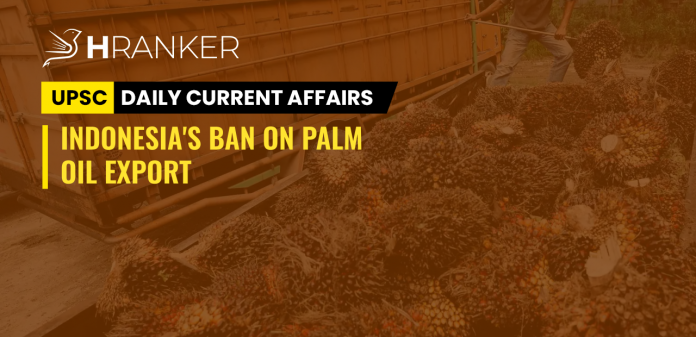WHAT’S IN NEWS:
Indonesia, the world’s top palm oil producer, announced plans to ban exports of the commodity which is the most used cooking oil in the world starting April 28. The move is expected to rock household economies globally and specially in India.
PRIMARY REASONS FOR THE IMPOSED BAN:
- Rising inflation in Indonesia due to global supply chain disruptions from the Russia-Ukraine war.
- The Indonesian president has stated that he would ensure that the availability of cooking oil in the domestic market becomes abundant and affordable.
This is not the first time the South East Asian country decided to arrest local pricesby banning exports. It had announced limited curbs in January too.
EFFECTS OF THE BAN ON THE WORLD:
- Global prices of crude palm oil, which Indonesia uses for cooking oil, have surged to historic highs this year amid rising demand and weak output from top producers Indonesia and Malaysia.
- Indonesia’s ban on palm oil exports is sending soaring cooking oil prices even higher worldwide, exacerbating global food security fears amid adverse weather and the war in Ukraine.
- This will soar inflation to even higher levels when the world is already suffering from surging prices.
- This means Malaysia gains from higher prices but won’t make up for the supply shock and so we should have a global supply shortage that impacts global food prices.
- This regulation could certainly trigger uncertainty from Indonesia’s trading partners, and the credibility of Indonesia as a trading partner could be questioned. Not to mention that this will disrupt previously agreed palm oil trading contracts.”
- Large supplies of alternatives including soy and rapeseed oil are not readily available either, after droughts hurt the most recent crops in Argentina, Brazil and Canada.
PROBABLE IMPACTS ON INDIA:
- The export ban could send food inflation soaring as India is the largest importer of palm oil from Indonesia.
- It imports about eight million tonnes of palm oil annually. The commodity accounts for nearly 40% share of India’s overall edible oil consumption basket.
- Experts speculate that palm oil prices could surge as much as 100-200% in India if the government fails to find a new source of palm oil.
- Cooking oil prices are already at record levels as the Ukraine war disrupted shipments of sunflower oil.
- Since palm oil and its derivatives are used in the production of several household goods, the impact of the ban could eat into the margins of Indian packaged consumer goods players. Firms such as Hindustan Unilever, Godrej, Nestle, Brittania etc could feel the impact of the ban in the near term.
- A surge in palm oil prices means it would also become expensive to dine out. The restaurant industry is already grappling with a 10-12 percent increase in operational costs due to inflation. And now with prices of palm oil set to surge again, the industry might pass on the costs to the consumers.
WHAT PRODUCTS ARE LIKELY TO BECOME MORE EXPENSIVE ?
- With the ban coming into place from Thursday, the prices of all major edible oils including palm oil, soy oil, sunflower oil, and rapeseed oil will see a bigger increase.
- Palm oil is used in many everyday items – from cakes to frying fats, from cosmetics to cleaning products, and from biofuels to detergents. It is used in chocolates, margarine, noodles, biscuits, soaps, and shampoos. A rise in palm oil prices then will impact the cost of all these consumer goods.
WAY FORWARD FOR INDIA:
- India will turn to Malaysia, which is the world’s second-largest producer of palm oil to plug the gap. But Malaysia is also facing a labour shortage owing to the pandemic which has resulted in a production shortfall. So it is unlikely to fill the gap.
- India could also explore the possibility of importing from Thailand and Africa- they produce three million tonnes each.
- India is expected to engage with Indonesia on an urgent basis before the ban comes into effect.
- Besides, the Centre is likely to negotiate with other oil-supplying nations in Latin America and Canada.
INDIAN INITIATIVES TO PROMOTE THE PRODUCTION OF PALM OIL:
- In view of the importance and significance of oil palm cultivation, Department of Agriculture, Cooperation and Farmers Welfare (DAC&FW) had taken up Technology Mission on Oilseeds & Pulses (TMOP) in 1991 – 92 in the potential states.
- A comprehensive Centrally Sponsored Scheme Oil Palm Development Programme (OPDP ) was taken up during Eighth & Ninth Plan.
- During the Tenth and Eleventh Plan, Government of India had provided support for oil palm cultivation under Centrally Sponsored Integrated Scheme of Oilseeds, Pulses, Oil Palm and Maize (ISOPOM).
- To boost oil palm cultivation, Government of India had implemented a Special Programme on Oil Palm Area Expansion (OPAE) under RKVY from the year 2011-12 to 2014-15.
- During the 12th Five Year Plan, a new National Mission on Oilseeds and Oil Palm (NMOOP) was launched under which Mini Mission – II (MM – II) was dedicated to oil palm area expansion and productivity increases. MM – II of NMOOP was implemented in 12 States. It identified two million hectares of cropland where palm oil could be cultivated.
- the Cabinet approved a ₹11,040 crore outlay over five years for the National Mission on Edible Oils – Oil Palm (NMEO-OP), emphasising on the argument of reducing India’s dependence on importing edible oils. It will be an umbrella scheme that will subsume all ither schemes.
- The government has also announced that ecologically sensitive northeastern states and eastern archipelago of the Andaman and Nicobar islands will be used for cultivation of the oil.




